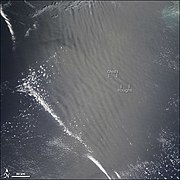#Gravity-Wave
Not to be confused with #Gravitational-Waves.
In fluid dynamics, gravity waves are waves generated in a fluid medium or at the interface between two media when the force of gravity or buoyancy tries to restore equilibrium. An example of such an interface is that between the atmosphere and the ocean, which gives rise to wind waves.
When a fluid element is displaced on an interface or internally to a region with a different density, gravity will try to restore it toward equilibrium, resulting in an oscillation about the equilibrium state or wave orbit.Gravity waves on an air–sea interface of the ocean are called surface gravity waves or surface waves, while gravity waves that are within the body of the water (such as between parts of different densities) are called internal waves. Wind-generated waves on the water surface are examples of gravity waves, as are #Tsunamis and #Ocean tides.
What are Gravity Waves?
•Gravity waves are buoyancy waves – the restoring force
comes from Archimedes’s principle.
•They involve vertical displacement of air parcels, along
slanted paths
•The waves are transverse with temperature and wind perturbations, δT and δw being the two free parameters
that oscillate for a freely propagating wave
•They are found everywhere in the atmosphere
•They can propagate vertically and horizontally,
transporting momentum from their source to their sink
•Global circulation models use GW parameterization
schemes to represent GW transfer of momentum -
major source of controversy
Wind-generated gravity waves on the free surface of the Earth's ponds, lakes, seas and oceans have a period of between 0.3 and 30 seconds (3 Hz to 0.03 Hz). Shorter waves are also affected by surface tension and are called gravity–capillary waves and (if hardly influenced by gravity)capillary waves. Alternatively, so-called infragravity waves, which are due to subharmonic nonlinear wave interaction with the wind waves, have periods longer than the accompanying wind-generated waves.
Atmosphere dynamics on Earth.
In the Earth's atmosphere, gravity waves are a mechanism for the transfer of momentum from the troposphere to the stratosphere. Gravity waves are generated in the troposphere by frontal systems or by airflow over mountains. At first, waves propagate through the atmosphere without appreciable change in mean velocity. But as the waves reach more rarefied (thin) air at higher altitudes, their amplitude increases, and nonlinear effects cause the waves to break, transferring their momentum to the mean flow.
This process plays a key role in studying the dynamics of the middle atmosphere.
The clouds in gravity waves can look like altostratus undulatus clouds, and are sometimes confused with them, but the formation mechanism is different.



No comments:
Post a Comment